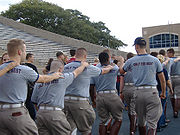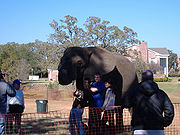.gif)
Elephant Walk (Texas A&M)
Encyclopedia
Elephant Walk is a tradition at Texas A&M University
in which the senior class walks around campus to remember the good times they had at Texas A&M. This tradition generally takes place the week before the Texas (University of Texas at Austin
) football game. It signifies the last time that the seniors will stand as a part of the 12th Man student body.
 In 1922, two freshman members of the Fightin' Texas Aggie Band
In 1922, two freshman members of the Fightin' Texas Aggie Band
, Oluf G. "Piccolo Red" Carson (Fort Worth, TX) and J. William "Sarge" Dorsey (Harlingen, TX), began playing a funeral march after losing a football
game. The two bandsmen, a piccolo player and a bass horn player respectively, began walking away slowly, like an elephant wandering away to die. Other members of the band fell in behind. They continued the march after each football game for the remainder of the season, regardless of the outcome. Following that first walk, the Aggies
began a winning streak, including a victory over their archrival, the University of Texas at Austin
. At the conclusion of the football season, their marches were discontinued.
In 1926, the senior class performed the march again to remember their four years at the Agricultural and Mechanical College of Texas. Led by the same two “Fish”, the seniors placed their hands on the shoulder of the cadet in front of them, untucked their shirts and put their hats on backwards indicating that they were out of uniform. They wandered around campus remembering the good and the bad times that they had while students at A&M, and those who had fallen over the years. An underclassman, who had never seen the march before, remarked that they looked like a bunch of old elephants looking for a place to die, hence the name of the tradition.
Before the 1999 collapse of Aggie Bonfire
, the parade of students was led by the eight senior Redpots
who supervised the Bonfire construction.
, today all seniors at Texas A&M are welcome to participate. The march of seniors often stretches for a mile (1.6 km) consisting of several thousand seniors. Before the walk, T-shirts and pictures with live elephants will be taken at the Clayton Williams Alumni Center. For the class of 2007, Elephant Walk began at Kyle Field for Yell practice and presentation of the class gift. From here seniors wander to many historic locations on campus including the 12th Man statue, the Quad, the Jack K Williams Administration Building, the H20 fountain and the Lawrence Sullivan Ross
Statue. Along the route, the group stops periodically to participate in yells. While marching, they will often sing Aggie songs, such as The Spirit of Aggieland. The walk ends with seniors immersing themselves in Fish Pond
. Underclassmen, non seniors, by tradition are not allowed to use the word Elephant as it’s considered a senior word.
In 1992, campus administration officials became upset over the destruction of campus property and increasing injury rates and mandated that Elephant Walk return to its solemn nature. With the encouragement of many former students, including the Class of 1926, which sent a letter asking students to respect the tradition, the school initiated a formal "Keep it Clean" campaign. This became known as Junior E-Walk.
Junior E-Walk begins minutes after Elephant Walk begins. To keep the two classes separate, the juniors march in the opposite direction of the seniors. E-Walk now symbolizes the junior class assuming their role as the leaders of the Twelfth Man.
 People for the Ethical Treatment of Animals
People for the Ethical Treatment of Animals
(PETA) has criticized the use of live elephants in Elephant Walk.
Texas A&M University
Texas A&M University is a coeducational public research university located in College Station, Texas . It is the flagship institution of the Texas A&M University System. The sixth-largest university in the United States, A&M's enrollment for Fall 2011 was over 50,000 for the first time in school...
in which the senior class walks around campus to remember the good times they had at Texas A&M. This tradition generally takes place the week before the Texas (University of Texas at Austin
University of Texas at Austin
The University of Texas at Austin is a state research university located in Austin, Texas, USA, and is the flagship institution of the The University of Texas System. Founded in 1883, its campus is located approximately from the Texas State Capitol in Austin...
) football game. It signifies the last time that the seniors will stand as a part of the 12th Man student body.
History

Fightin' Texas Aggie Band
The Fightin' Texas Aggie Band is the official marching band of Texas A&M University. Composed of over 300 men and women from the school's Corps of Cadets, it is the largest military marching band in the world...
, Oluf G. "Piccolo Red" Carson (Fort Worth, TX) and J. William "Sarge" Dorsey (Harlingen, TX), began playing a funeral march after losing a football
College football
College football refers to American football played by teams of student athletes fielded by American universities, colleges, and military academies, or Canadian football played by teams of student athletes fielded by Canadian universities...
game. The two bandsmen, a piccolo player and a bass horn player respectively, began walking away slowly, like an elephant wandering away to die. Other members of the band fell in behind. They continued the march after each football game for the remainder of the season, regardless of the outcome. Following that first walk, the Aggies
Texas A&M Aggies
Texas A&M Aggies refers to the students, graduates, and sports teams of Texas A&M University. The nickname "Aggie" is common at land-grant or "Ag" schools in many states. The teams compete in Division I of NCAA sports...
began a winning streak, including a victory over their archrival, the University of Texas at Austin
University of Texas at Austin
The University of Texas at Austin is a state research university located in Austin, Texas, USA, and is the flagship institution of the The University of Texas System. Founded in 1883, its campus is located approximately from the Texas State Capitol in Austin...
. At the conclusion of the football season, their marches were discontinued.
In 1926, the senior class performed the march again to remember their four years at the Agricultural and Mechanical College of Texas. Led by the same two “Fish”, the seniors placed their hands on the shoulder of the cadet in front of them, untucked their shirts and put their hats on backwards indicating that they were out of uniform. They wandered around campus remembering the good and the bad times that they had while students at A&M, and those who had fallen over the years. An underclassman, who had never seen the march before, remarked that they looked like a bunch of old elephants looking for a place to die, hence the name of the tradition.
Before the 1999 collapse of Aggie Bonfire
Aggie Bonfire
Aggie Bonfire was a long-standing tradition at Texas A&M University as part of the college rivalry with the University of Texas at Austin. For 90 years, Texas A&M students—known as Aggies—built and burned a bonfire on campus each autumn...
, the parade of students was led by the eight senior Redpots
Aggie Bonfire leadership
The Aggie Bonfire leadership was composed of Texas A&M University students who were in charge of the construction of Aggie Bonfire, known as Bonfire, a large bonfire burned on the Texas A&M University campus annually from 1909 until 1999. The Aggie Bonfire Leadership was responsible for safely...
who supervised the Bonfire construction.
Modern Observance
Though started by the Corps of CadetsTexas A&M University Corps of Cadets
The Texas A&M University Corps of Cadets is a student military organization at Texas A&M University...
, today all seniors at Texas A&M are welcome to participate. The march of seniors often stretches for a mile (1.6 km) consisting of several thousand seniors. Before the walk, T-shirts and pictures with live elephants will be taken at the Clayton Williams Alumni Center. For the class of 2007, Elephant Walk began at Kyle Field for Yell practice and presentation of the class gift. From here seniors wander to many historic locations on campus including the 12th Man statue, the Quad, the Jack K Williams Administration Building, the H20 fountain and the Lawrence Sullivan Ross
Lawrence Sullivan Ross
Lawrence Sullivan "Sul" Ross was the 19th Governor of Texas , a Confederate States Army general during the American Civil War, and a president of the Agricultural and Mechanical College of Texas, now called Texas A&M University.Ross was raised in the Republic of Texas, which was later annexed to...
Statue. Along the route, the group stops periodically to participate in yells. While marching, they will often sing Aggie songs, such as The Spirit of Aggieland. The walk ends with seniors immersing themselves in Fish Pond
Fish pond
A fish pond, or fishpond, is a controlled pond, artificial lake, or reservoir that is stocked with fish and is used in aquaculture for fish farming, or is used for recreational fishing or for ornamental purposes...
. Underclassmen, non seniors, by tradition are not allowed to use the word Elephant as it’s considered a senior word.
Junior E-Walk
In the 1980s, juniors often attempted to disrupt the seniors' march, armed with water balloons, shaving cream, and baby powder. The 6th and 13th squadrons from the Corps of Cadets often acted as a scout for the rest of the group, disarming any juniors they saw before the main group arrived at that location. The hijinks resulted in injuries at times, with four people suffering fractured bones in the 1986 event.In 1992, campus administration officials became upset over the destruction of campus property and increasing injury rates and mandated that Elephant Walk return to its solemn nature. With the encouragement of many former students, including the Class of 1926, which sent a letter asking students to respect the tradition, the school initiated a formal "Keep it Clean" campaign. This became known as Junior E-Walk.
Junior E-Walk begins minutes after Elephant Walk begins. To keep the two classes separate, the juniors march in the opposite direction of the seniors. E-Walk now symbolizes the junior class assuming their role as the leaders of the Twelfth Man.
Criticism

People for the Ethical Treatment of Animals
People for the Ethical Treatment of Animals is an American animal rights organization based in Norfolk, Virginia, and led by Ingrid Newkirk, its international president. A non-profit corporation with 300 employees and two million members and supporters, it claims to be the largest animal rights...
(PETA) has criticized the use of live elephants in Elephant Walk.

